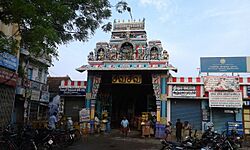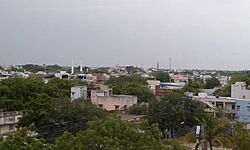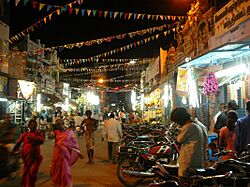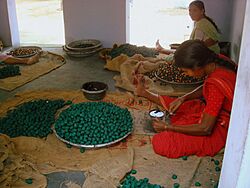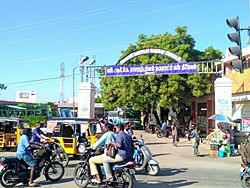Sivakasi facts for kids
Quick facts for kids
Sivakasi
Little Japan of India
|
|
|---|---|
|
Municipal corporation
|
|
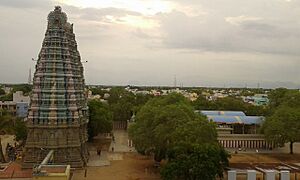
Image of town around the tower of Badrakali Amman Temple
|
|
| Nickname(s):
Little Japan of India, Cracker City of India
|
|
| Country | |
| State | |
| District | Virudhunagar |
| Revenue Division | Sivakasi |
| Taluk | Sivakasi |
| Founded by | Harikesari Parakkirama Pandian |
| Named for | The deity Shiva and the city Kashi (Varanasi) |
| Government | |
| • Type | Municipal Corporation |
| • Body | Sivakasi Corporation |
| Area | |
| • Total | 46.27 km2 (17.86 sq mi) |
| Elevation | 127 m (417 ft) |
| Population
(2021)
|
|
| • Total | 160,047 |
| • Density | 3,459.0/km2 (8,958.7/sq mi) |
| Demonym(s) | Sivakasian Sivakasikaran |
| Languages | |
| • Official | Tamil |
| Time zone | UTC+5:30 (IST) |
| PIN |
626123, 626124, 626189, 626130
|
| Telephone code | 04562 |
| Vehicle registration | TN 67, TN 84, TN 95 |
Sivakasi is a city in Virudhunagar District in the Indian state of Tamil Nadu. The city is known for firecrackers and match factories that produce 70% of the country's produce. The printing industries in Sivakasi produce 30% of the total diaries produced in India. The industries in Sivakasi employ over 25,000 people and the estimated turnover of the firecracker, match making and printing industries in the city is around ₹20 billion (US$340 million). The major issues in the city are the frequent accidents in the firecracker factories and the high level of child labour.
Sivakasi was established in the 15th century during the reign of the Pandya king Harikesari Parakkirama Pandian. The city was a part of Madurai and has been ruled at various times by Later Pandyas, Vijayanagar Empire, Madurai Nayaks, Chanda Sahib, Carnatic kingdom and the British. A major riot during the British Raj took place in 1899.
Sivakasi has a dry weather, making it suitable for dry crops like cotton, chillies and millets. Badhrkali Amman temple is the most prominent landmark of Sivakasi, and the temple festivals constitute the major festivals of the city. AJ and Hatsun Indoor Stadium has a coaching center for badminton and is the major sporting venue of the city. Sivakasi is a part of Sivakasi constituency and elects its member of legislative assembly every five years, and a part of the Virudhunagar constituency that elects its member of parliament. Sivakasi is locally administered by a municipal corporation which covers an area of 6.8 km2 (2.6 sq mi). Roadways is the major mode of transport to the city, while it has also got rail connectivity. As of 2021, Sivakasi has an estimated population of 160,047.
Contents
History
Sivakasi was established during the early 15th century CE. Between 1428 and 1460, a Pandya king Harikesari Parakkirama Pandian ruled the southern part of Madurai region (comprising modern-day Sivakasi and its surroundings). Hindu legend relates that he wanted to construct a temple for the Hindu god Shiva at Tenkasi and went to Kasi to bring a lingam (an iconic representation of Shiva). While returning to his palace with the prized lingam, he rested under the grove of a vilva tree, the favourite tree of Shiva. When a cow carrying the lingam refused to move from the spot, the king realised that the wishes of Shiva were different from his own, and he placed the lingam in the place where the cow halted. The place where the "Shiva lingam brought from Kasi" was installed came to be known as Sivakasi. Sivakasi was a part of the Madurai region during the 16th century. Madurai became independent from the Vijayanagar Empire in 1559 under the Nayaks. Nayak rule ended in 1736 and Madurai was repeatedly captured several times by Chanda Sahib (1740–1754), Arcot Nawab and Muhammed Yusuf Khan (1725–1764) in the middle of the 18th century. In 1801, Madurai came under the direct control of the British East India Company and was annexed to the Madras Presidency.
The mutual confrontation between the Maravars and Nadars reached its peak in 1899, leading to a series of riots which became known as the Sivakasi riots. A total of 22 people were killed, as many as 800 houses and the Big Chariot in the center of the city (used by the temple during festivals) were burnt during the riots. Eventually, the riots came to an end after the intervention of the military in mid-July 1899.
The Sivakasi municipality was established in 1920. After India's independence from the British in 1947, Sivakasi continued to be a municipality under the Madras state and later a part of Tamil Nadu, when the state was split on linguistic lines during 1953, 1956 and 1960 and renamed in 1968. It was promoted to a second-grade municipality in 1978, first-grade in 1978, selection-grade in 1998, special-grade in 2013 and proposed to be upgraded as municipal corporation in 2017. On 31-December-2020, both Sivakasi and Thiruthangal are merged with a view to promote Sivakasi as municipal corporation. It is declared as Municipal Corporation on 24-August-2021 in Tamil Nadu legislative assembly. Over the decades after independence, Sivakasi grew as an industrial city specialising in firecracker, match and printing industries. Several incidents of fire and explosions have occurred in the fireworks factories.
Geography
Sivakasi is located at 9°27′00″N 77°49′00″E / 9.45°N 77.8167°E and has an average elevation of 101 metres (331 feet). The city is located in Virudhunagar district of the South Indian state, Tamil Nadu, at a distance of 74 km (46 mi) from Madurai. Sivakasi is located to the east of Western Ghats and to the west of Sattur. The topography is almost plain, with no major geological formation. There are no notable mineral resources available in and around the city. The soil types are black and red that are conducive to cotton, chillies, and millets. These crops are predominant because of poor groundwater supply and soil type. Sivakasi experiences hot and dry weather throughout the year. The temperature ranges from a maximum of 39 °C (102 °F) to a minimum of 23 °C (73 °F). Like the rest of the state, April to June are the hottest months and December to January are the coldest. Sivakasi receives scanty rainfall with an average of 812 mm (32.0 in) annually, which is lesser than the state average of 1,008 mm (39.7 in). The Southwest monsoon, with an onset in June and lasting up to August, brings scanty rainfall. The bulk of the rainfall is received during the North East monsoon in the months of October, November and December. The average humidity of the city is 76.2% and varies between 65.6% to 79.2%. The municipality covers an area of 6.8 km2 (6,800,000 m2).
Demographics
| Religious census | ||||
|---|---|---|---|---|
| Religion | Percent(%) | |||
| Hindu | 85.42% | |||
| Muslim | 9.21% | |||
| Christian | 5.2% | |||
| Sikh | 0.01% | |||
| Jain | 0.06% | |||
| Other | 0.08% | |||
| No religion | 0.01% | |||
| Historical population | ||
|---|---|---|
| Year | Pop. | ±% |
| 1951 | 22,674 | — |
| 1961 | 30,690 | +35.4% |
| 1971 | 44,883 | +46.2% |
| 1981 | 59,827 | +33.3% |
| 1991 | 65,593 | +9.6% |
| 2001 | 71,040 | +8.3% |
| 2011 | 721,700 | +915.9% |
Sources:
|
||
According to 2011 census, Sivakasi had a population of 71,040 with a sex-ratio of 1,009 females for every 1,000 males, much above the national average of 929. A total of 6,963 were under the age of six, constituting 3,474 males and 3,489 females. Scheduled Castes and Scheduled Tribes accounted for 8.35% and 0.25% of the population, respectively. The average literacy of the city was 79.62%, compared to the national average of 72.99%. The city had a total of 18,952 households. There were a total of 29,342 workers, comprising 22 cultivators, 135 main agricultural labourers, 955 in household industries, 27,662 other workers, 568 marginal workers, 6 marginal cultivators, 3 marginal agricultural labourers, 79 marginal workers in household industries and 480 other marginal workers.
As per the religious census of 2011, Sivakasi had 85.42% Hindus, 9.21% Muslims, 5% Christians, 0.01% Sikhs, 0.06% Jains, 0.08% following other religions and 0.01% following no religion or did not indicate any religious preference.
In 2001, 16 slums were identified in the city and a total of 34,029 people resided in the slums. The slum population increased from 42% to 47% during the period of 1991–2001. The high decadal growth of population during the 1961–71 period is attributed to the high level of industrialisation during the period. The density of population increased from 9,646 persons per km2 in 1991 to 10,613 persons per km2 in 2001. The wards along the Virudhunagar, Sattur, Srivilliputhur and Vembakottai corridors have registered increased commercial and residential activity.
Majority of the residents are engaged in the secondary sector involving match works, fireworks, and printing industry. During the 2001 census, the occupational pattern indicated the increasing presence of the tertiary sector. The agricultural output of the city is limited, due to the lack of favourable geographical and climatic conditions.
Education and utility services
In 2011, there were five government schools: two primary schools, one middle school, one high school and one higher secondary school. There were ten other private schools in the city. There were two engineering colleges in the city, with the Mepco Schlenk Engineering College being prominent among them. There were three arts and science colleges and three polytechnic colleges in the city. Sri Kaliswari College is located within the city. Electricity supply to Sivakasi is regulated and distributed by the Tamil Nadu Electricity Board (TNEB). The city along with its suburbs forms the Sivakasi Electricity Distribution Circle. A Chief Distribution engineer is stationed at the regional headquarters. Water supply is provided by the Sivakasi Municipality from the Vaippar river through eight reservoirs and six feeders located in various parts of the city. In the period 2000–2001, a total of 6.5 million litres of water was supplied every day for households in the city.
As per the municipal data for 2011, about 45 metric tonnes of solid waste were collected from Sivakasi every day by door-to-door collection and subsequently the source segregation and dumping was carried out by the sanitary department of the Sivakasi municipality. The coverage of solid waste management in the city by the municipality had an efficiency of 100% in 2001. There is no underground drainage system in the city and the sewerage system for disposal of sullage is through septic tanks, open drains and public conveniences. The municipality maintained a total of 85.87 km (53.36 mi) of storm water drains in 2011. In 2011, there was one government hospital, three municipal health centres, one municipal maternity home and 25 private hospitals and clinics that take care of the healthcare needs of the citizens. In 2011, the municipality maintained a total of 2,584 street lamps: 322 sodium lamps, 125 mercury vapour lamps, 2,136 tube lights and one high mast beam lamp. The municipality operates two markets, namely the Anna Daily Market and Viswanatham Municipal Meat Market that cater to the needs of the city and the rural areas around it.
Economy
The economy of Sivakasi is dependent on three major industries: firecrackers, matchbox manufacturing, and printing. The city has 520 registered printing industries, 53 match factories, 32 chemical factories, seven soda factories, four flour mills and two rice and oil mills. The city is the nodal center for firecracker manufacturing at the national level. In 2020 there are around 1070 registered firecracker manufacturing companies in sivakasi and 8 lakh (800,000) people were directly and indirectly employed by the industry. Some of the private enterprises had an annual turnover of ₹5 billion (US$85 million). In 2011, the combined estimated turnover of the firecracker, matchbox making and printing industry in the city was around ₹20 billion (US$340 million). Approximately 70% of the firecrackers and matches produced in India are from Sivakasi. The hot and dry climate of the city is conducive to the firecracker and matchbox making industries. The raw materials for these industries were procured from Sattur earlier but were discontinued due to the high power and production cost. The source of raw materials is Kerala and Andaman. The paper for the printing industry is procured from various states. The city is a major producer of diaries, contributing to 30% of the total diaries produced in India. Printing industry in the city was initially utilized for printing labels for the firecrackers and later evolved with modern machinery to grow as a printing hub. In 2012, all the industries suffered 15–20% production loss due to power shortage and escalating labor cost.
The major issues in the fireworks industry in Sivakasi is child labour and frequent accidents.
Child labour in the industries, especially in matchbox making factories, was at its peak during the 1970s and 1980s. In 1981, the child workforce in the age group 4–16 was 30% of the total workforce, 90% of whom were girls. In 1986, the National Child Labour project estimated child labour in Sivakasi matchbox making industries to be 14,121 children. The estimates indicated 80% of the child labour belonging to Scheduled Castes (SC), who were marginalised for centuries for cheap labour. Poverty and lack of farm produce were stated as the main reason for child labour. The employers also preferred children because of ease of management, discipline, and lack of labour unions. The children in these industries suffered from a backache, neckache, tuberculosis, malnutrition, gastrointestinal disorders, dermatitis, respiratory disorders, over-exhaustion, burn injuries and water-borne diseases due to exposure to harmful chemicals in the work environment. The situation of the child labour came to light during an accident of a bus transporting the children in 1976. The central government appointed a one-man committee under Harbans Singh in 1978, who reported abolishing child labour would seriously impact the economy of the region. The National Policy on child labour was formulated by the central government in August 1987, aiming at the rehabilitation of children withdrawn from these factories. In 1988, the union labour ministry initiated a programme for providing informal education, free healthcare and free lunch for children working in the factories. The Supreme Court of India, in a judgement, ruled in December 1996 indicating provisions for preventing child labour like compensation for the child employed, employment to the adult members of the family and contribution to the corpus fund by the state government. From the establishment of child labour Act in 1986 till 2011, 150,000 inspections on child labour have been conducted in the factories, 1,500 cases have been registered and few prosecutions have been made. The results indicated a small amount of child labour in the cottage and household industries.
Transportation
The Sivakasi municipality maintains 65.151 km (40.483 mi) of the road. The city has 13.035 km (8.100 mi) concrete road and 52.116 km (32.383 mi) bituminous road. A total of 2.5 km (1.6 mi) of state highways is maintained by the State Highways Department. Four major roads connect the city with Sattur, Virudhunagar, Srivilliputhur and Vembakottai; there are no bypass roads around the city. There are eight major intersections located across different parts in these major roads.
Sivakasi is served by city bus service, which provides connectivity within the city and the suburbs. Minibus service operated by private companies cater to the local transport needs. The city bus routes to surrounding villages are to Puliparaipatti, Thayilpatti, Madathupatti Vilampatti, Alangulam, Vilampatti, Alangulam, M.Pudupatti, Alamarathupatti, Sengamalapatti, Muthalipatti, and Meenampatti. The main bus stand covers an area of 1.39 acres (5,600 m2) and is located in the heart of the city. The Tamil Nadu State Transport Corporation operates daily services connecting various cities to Sivakasi. The State Express Transport Corporation operates long-distance buses connecting the city to important cities like Chennai, Bangalore, Tiruppur and Thoothukudi. The major intercity bus routes from the city are to cities like Madurai, Chennai, Erode, Karur, Coimbatore, Karaikudi, Dindigul, Trichy, Ramanathapuram, Thanjavur, Sankarankovil, Sengottai, Rajapalayam, Tenkasi, Kovilpatti, Tiruppur, Dharapuram, Oddanchatram, Thoothukudi, Tiruchendur, Nagercoil and Tirunelveli. Being an industrial city, there is significant truck transport with around 400–450 trucks entering the city for loading and unloading activities daily. Three wheelers, called autos are also a common public transport system.
Sivakasi railway station is located in the rail head from Madurai to Sengottai. It connects Tamil Nadu with Kerala through Rajapalayam and Sengottai. The Podhigai Express connects Sivakasi to Sengottai and Chennai Egmore in either directions. All other express trains ply from Virudunagar station. There are also passenger trains running either direction from Madurai to Shencottah. There is another railway station at Thiruthangal, which caters to the locality of Thiruthangal, where passenger trains, Podhigai Express and Silambu Express stops.
Nearby international airport is Madurai international Airport situated in 70km away.
Culture
Arulmigu Viswanatha Swamy Temple is the important ancient temple in Sivakasi built by Pandya King Arikesari Parakkirama Pandian between 1428 and 1460 during his reigns.
Badhrakali Amman temple is one of the prominent temple of Sivakasi. The tower or Rajagopuram of this temple has a breadth of 66 ft (20 m), a width of 44 ft (13 m) and a height of 110 ft (34 m). "Panguni Pongal" and "Chithirai Pongal" are the annual festivals celebrated for the deities Mariamman and Badrakali Amman in April and May, respectively, both of which are celebrated for ten days.
Periya Palli Vasal mosque and Chinna Palli Vasal mosque are two of the most prominent mosques in the city. The CSI Regland Memorial Church is the prominent church.
Notable people
- Thondar Duraiswamy (1915–1971), Indian freedom movement comrade
- Sridevi (1963-2018), Indian actress
Sports
AJ Indoor Stadium on Velayutham Road, a coaching center for badminton, table tennis, and basketball. This is a major sporting venue in Sivakasi. Many district, state and national level badminton championship matches are held in this stadium.




